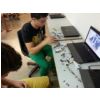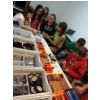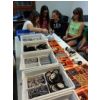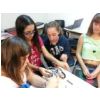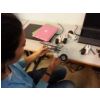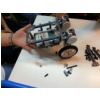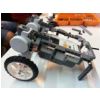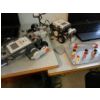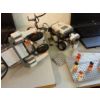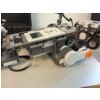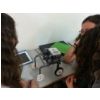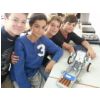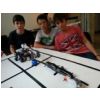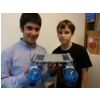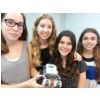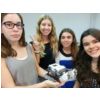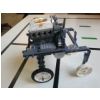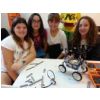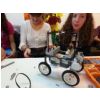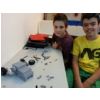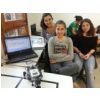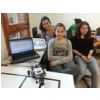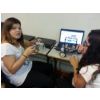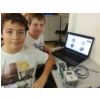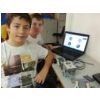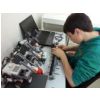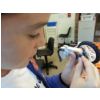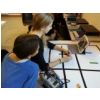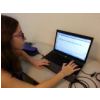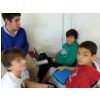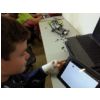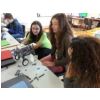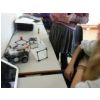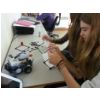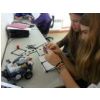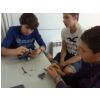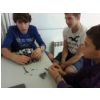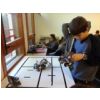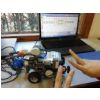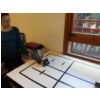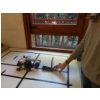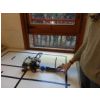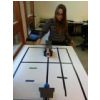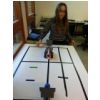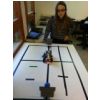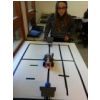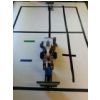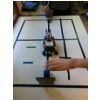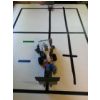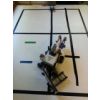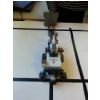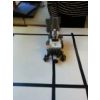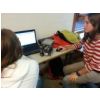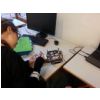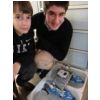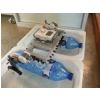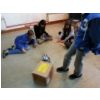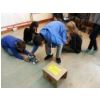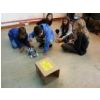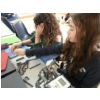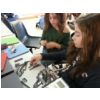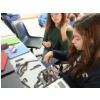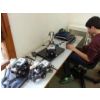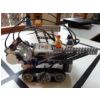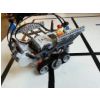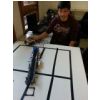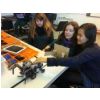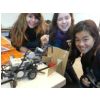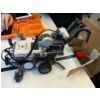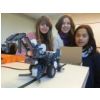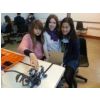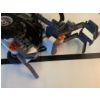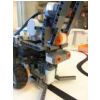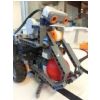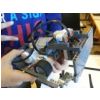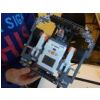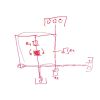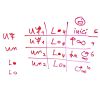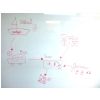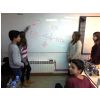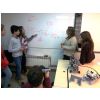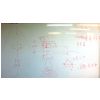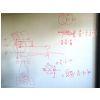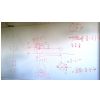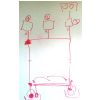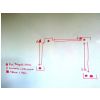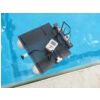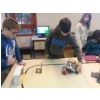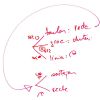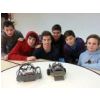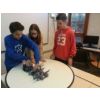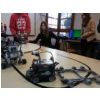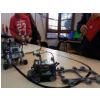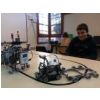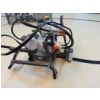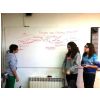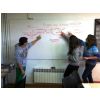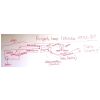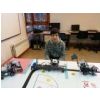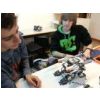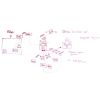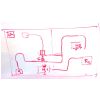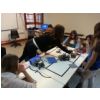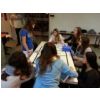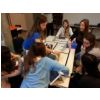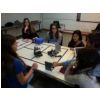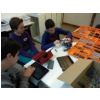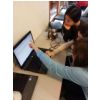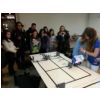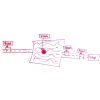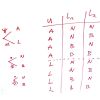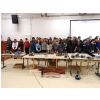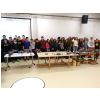Robo-telling stories (conta una història amb un robot), projectes de robòtica dels alumnes de Tecnologia de 2on de ESO, Escola Garbí, Esplugues
27-02-14
L'objectiu del curs és assegurar que els estudiants es diverteixen amb el que fan, aprenen jugant, dissenyen històries i resolen problemes que els interessen i els motiven per recordar el que aprenen, aprenen els instruments per transformar-se en actors en comptes de ser simples consumidors de tecnologia, aprenen les paraules tècniques en Anglès, Castellà i Català, entenen els seus propis dispositius tecnològics, treballen en grups, negocien i col·laboren amb els seus companys/es, aprenen entre si, d'altres i ajuden a altres per aprendre al seu propi ritme, registren en un diari el seu disseny i processos d'aprenentatge (que és més important que el resultat), dissenyen presentacions i expliquen en públic els seus projectes i el que han après, i mostren i comuniquen la passió respecte al que fan. A més, crec que aprendre a programar és una activitat intel·lectual fonamental que tot alumne ha d'aprendre, i si els alumnes utilitzen la robòtica educativa, això els hi facilita interactuar amb el món real.
Per tant, els estudiants han d'imaginar una història, per construir els seus propis robots i representar aquesta història, i els programen per realitzar el que han imaginat, de forma autònoma i prenent decisions utilitzant sensors. Els alumnes passen per un procés fonamental de prova i error (que han d'informar en un diari, la qual cosa és fonamental per assegurar el seu aprenentatge) que els permet millorar amb el temps els aspectes de construcció així com la programació dels seus robots.
El curs –2 classes de 36 alumnes amb sessions setmanals de 2 hores amb mig grup, on utilitzem la tecnologia de LEGO Mindstorms–, és molt dinàmic, interactiu i exigent de dirigir, perquè molts projectes diferents es realitzen al mateix temps i els alumnes aprenen conceptes similars a temps diferents. Per una banda, és bastant estressant perquè cal solucionar, al mateix temps, molts problemes que mai s'han trobat abans. Per una altra banda, requereix més temps perquè cal repetir els mateixos conceptes tècnics moltes vegades, sempre que cada equip d'estudiants ho necessiti. Però aquesta estratègia assegura un major número d'alumnes motivats i que aquests recordin el que han aprés, no només respecte de la programació, també respecte de tècniques de construcció i de tots els aspectes relacionats amb el procés tecnològic i la creació d'un artefacte, perquè senten la necessitat i l'interès.
Un exemple dels projectes d'aquest any, que encara que molt diversos, molts estan relacionats entre si mitjançant una història global de la classe, és: el disseny de vaixells diferents, un globus, un cotxe telecomandat amb una càmera de vídeo controlada per un segon robot via Bluetooth, un autobús que recull el públic per dur-lo a un estadi de lluita de Sumo, els robots de Sumo, un robot expenedor de pizzes, un grup d'animadores de Sumo que ballen al ritme de la música, una ambulància que va a un hospital fent aturades pel camí i rebent encàrrecs d'aquest via Bluetooth, un robot trepador, un robot de rescat amfibi que pot entrar dins l'aigua per recollir una víctima, un dragstrer de carreres, etc.
Com ajuda al curs, he dissenyat un curs d'introducció a la robòtica de LEGO Mindstorms amb tota la informació tècnica i conceptual, que està publicat en l'apartat de "cursos i exercicis" d'aquesta web, i els alumnes poden accedir-hi quan ho necessiten, de tal manera que poden aprendre els conceptes sobre demanda.
Us animo a provar la tecnologia de la robòtica educativa per potenciar la creativitat dels alumnes dins les matèries STEM i descobrir que pot ser molt divertit.
Aquest projecte es va presentar al Concurs de professors inGenious de la UE i va ser un dels 21 semi-finalistes. Durant el curs d'estiu inGenious 2014 a Split, Croàcia, es va seleccionar com a màxim finalista amb altres 6 projectes. Els màxims finalistes europeus van ser convidats a la European Ceremony Award que va tenir lloc a Varsòvia el 22 de setembre, conjuntament amb la STEM Educator Academy EMEA countries, on va guanyar el concurs el projecte portuguès "Salsicheiro por um dia...Sausage maker for one day...", enhorabona!
In Spain, during the 2nd year of Secondary School students have a curricular subject called "technology". The Department of Education states that the students have to learn applications, understand information management, enhance communication and collaboration, and encourage a healthy use of IT and digital identity.
The goal of the course is to make sure that students enjoy what they do, learn by playing, design stories and solve problems that interest and motivate them to remember what they learn, learn the tools to become actors instead of simple consumers of technology, learn the technical words in English, Spanish and Catalan, understand their own technological gadgets, work in groups, negotiate and collaborate with their peers, learn with each other, from others and help others to learn at their own pace, record in a diary their design and learning processes (which is more important than the result), design presentations and explain in public their projects and what they have learnt, and show and communicate the passion about what they do. In addition, I believe that learning how to code is a fundamental intellectual activity that every student must learn, and if students use educational robotics, they are able to interact with the real world.
Thus, the students are required to imagine a story, to build their own robots to represent this story, and they program them to accomplish what they have imagined, autonomously and taking decisions using sensors. The students go through a fundamental process of trial and error (that they have to inform in a diary, which is fundamental to ensure their learning) that allow them to improve through time construction aspects as well as their robots programming.
The course -2 classes of 36 students based on weekly sessions of 2 hours with half a group, where we use LEGO Mindstorms technology-, is very dynamic, interactive and demanding to conduct, because many different projects take place at the same time and the students learn similar concepts at different times. On the one hand, it is quite stressing because you will need to solve, at the same time, many different problems that you have never encountered before. On the other hand, it is more time consuming because you will need to repeat the same technical concepts many times, whenever each team of students needs them. But this strategy ensures that a highest number of students are motivated and remember what they learn, not only about programming, but also about construction techniques and all aspects related to the technology process and the creation of an artifact, because they feel the need and the interest.
An example of this year projects, that although very diverse, many of them are related to each other in a global class story, is: the design of different boats, a balloon, a remote controlled car with a video camera controlled by a second robot via Bluetooth, a bus which takes the public to a robot Sumo fight arena, the Sumo robots, a pizza delivery robot, a group of Sumo cheerleaders dancing in coordination with the music, an ambulance that goes to a hospital making several stops on its way and receiving assignments from it via Bluetooth, a climbing robot, an amphibious rescue robot that can enter into the water to pick up a victim, a speed dragster, etc.
To support the course, I designed a LEGO Mindstorms robotics introduction course with all the technical and conceptual information, which is published in this web at the "courses and exercises" section, and the students can access it whenever they need it, so they can learn the concepts on demand.
I encourage you to try the educational robotics technology to encourage the students' creativity inside STEM subjects and discover that it can be very fun.
This project was presented to the EU inGenious Teacher Competition and it was selected as one of the 21 semi-finalists. During the inGenious Summer School 2014 in Split, Croacia, it was selected as top European finalist with other 6 projects. The top European finalists were invited to the European Ceremony Award that took take place in Warsaw, on September 22 in conjunction with the STEM Educator Academy EMEA countries, where the Portuguese project "Salsicheiro por um dia...Sausage maker for one day..." won the award, congratulations!
El objetivo del curso es asegurar que los estudiantes se divierten con lo que hacen, aprenden jugando, diseñan historias y resuelven problemas que les interesan y los motivan para recordar lo que aprenden, aprenden los instrumentos para transformarse en actores en vez de ser simples consumidores de tecnología, aprenden las palabras técnicas en Inglés, Castellano y Catalán, entienden sus propios dispositivos tecnológicos, trabajan en grupos, negocian y colaboran con sus compañeros/as, aprenden entre sí, de otros y ayudan a otros para aprender a su propio ritmo, registran en un diario su diseño y procesos de aprendizaje (que es más importante que el resultado), diseñan presentaciones y explican en público sus proyectos y lo que han aprendido, y muestran y comunican la pasión respecto a lo que hacen. Además, creo que aprender a programar es una actividad intelectual fundamental que todo alumno debe aprender, y si los alumnos utilizan la robótica educativa, ello les facilita interactuar con el mundo real.
Por tanto, los estudiantes deben imaginar una historia, para construir sus propios robots y representar esta historia, y los programan para realizar lo que han imaginado, de forma autónoma y tomando decisiones utilizando sensores. Los alumnos pasan por un proceso fundamental de prueba y error (que tienen que informar en un diario, lo que es fundamental para asegurar su aprendizaje) que les permite mejorar con el tiempo los aspectos de construcción así como la programación de sus robots.
El curso –2 clases de 36 alumnos con sesiones semanales de 2 horas con medio grupo, dónde utilizamos la tecnología de LEGO Mindstorms–, es muy dinámico, interactivo y exigente de dirigir, porque muchos proyectos diferentes se realizan al mismo tiempo y los alumnos aprenden conceptos similares a tiempos diferentes. Por un lado, es bastante estresante porque hay que solucionar, al mismo tiempo, muchos problemas que nunca se han encontrado antes. Por otra parte, requiere más tiempo porque hay que repetir los mismos conceptos técnicos muchas veces, siempre que cada equipo de estudiantes los necesite. Pero esta estrategia asegura un mayor número de alumnos motivados y que éstos recuerden lo que han aprendido, no solamente respecto a la programación, también respecto a técnicas de construcción y a todos los aspectos relacionados con el proceso tecnológico y la creación de un artefacto, porque sienten la necesidad y el interés.
Un ejemplo de los proyectos de este año, que aunque muy diversos, muchos están relacionados entre sí mediante una historia global de la clase, es: el diseño de barcos diferentes, un globo, un coche teledirigido con una cámara de vídeo controlada por un segundo robot vía Bluetooth, un autobús que recoge el público para llevarlo a un estadio de lucha de Sumo, los robots de Sumo, un robot expendedor de pizzas, un grupo de animadoras de Sumo que bailan al ritmo de la música, una ambulancia que va a un hospital haciendo varias paradas en el camino y recibiendo encargos de éste vía Bluetooth, un robot trepador, un robot de rescate anfibio que puede entrar en el agua para recoger una víctima, un dragster de carreras, etc.
Como ayuda al curso, he diseñado un curso de introducción a la robótica de LEGO Mindstorms con toda la información técnica y conceptual, que está publicado en el apartado de "cursos y ejercicios" de esta web, y los alumnos pueden acceder a él cuando lo necesitan, de tal manera que pueden aprender los conceptos sobre demanda.
Os animo a probar la tecnología de la robótica educativa para potenciar la creatividad de los alumnos dentro de las materias STEM y descubrir que puede ser muy divertida.
Este proyecto se presentó al Concurso de profesores inGenious de la UE i fue uno de los 21 semi-finalistas. Durante el curso de verano inGenious 2014 en Split, Croacia, fue seleccionado como máximo finalista con otros 6 proyectos. Los máximos finalistas europeos fueron invitados a la European Ceremony Award que se celebró en Varsovia el 22 de septiembre, conjuntamente con la STEM Educator Academy EMEA countries, dónde ganó el concurso el proyecto protugués "Salsicheiro por um dia...Sausage maker for one day...", ¡enhorabuena!



Projecte seleccionat com a màxim finalista europeu durant l'Escola d'Estiu inGenius 2014 a Split, Croàcia
Project selected as top European finalist during the inGenius Summer School 2014 in Split, Croacia
Proyecto seleccionado como máximo finalista europeo durante la Escuela de Verano inGenious 2014 en Split, Croacia
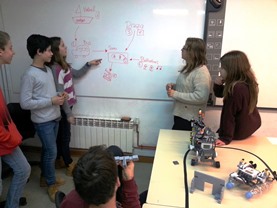
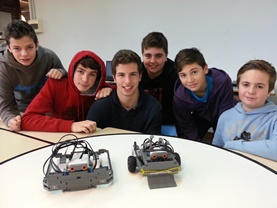
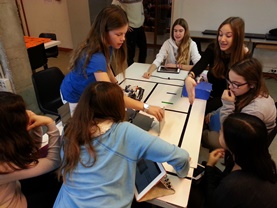
Robo-telling stories vídeo
Vídeo resum del taller produït pels alumnes
Workshop video summary produced by the students
Vídeo resumen producido por los alumnos
Presentacions prèvies d'alguns projectes - Some intial project presentations - Presentaciones previas de algunos proyectos
Vídeo-història produïda per un grup d'alumnes
Video-story produced by a group of students
Vídeo-historia producida por un grupo de alumnos
Cotxe telecomandat amb càmera de vídeo ambdós controlats per un segon robot via Bluetooth
Remote controlled car with a video camera both controlled by a second robot via Bluetooth
Coche teledirigido con una cámara de vídeo ambos controlados por un segundo robot vía Bluetooth
Per tant, els estudiants han d'imaginar una història, per construir els seus propis robots i representar aquesta història, i els programen per realitzar el que han imaginat, de forma autònoma i prenent decisions utilitzant sensors. Els alumnes passen per un procés fonamental de prova i error (que han d'informar en un diari, la qual cosa és fonamental per assegurar el seu aprenentatge) que els permet millorar amb el temps els aspectes de construcció així com la programació dels seus robots.
El curs –2 classes de 36 alumnes amb sessions setmanals de 2 hores amb mig grup, on utilitzem la tecnologia de LEGO Mindstorms–, és molt dinàmic, interactiu i exigent de dirigir, perquè molts projectes diferents es realitzen al mateix temps i els alumnes aprenen conceptes similars a temps diferents. Per una banda, és bastant estressant perquè cal solucionar, al mateix temps, molts problemes que mai s'han trobat abans. Per una altra banda, requereix més temps perquè cal repetir els mateixos conceptes tècnics moltes vegades, sempre que cada equip d'estudiants ho necessiti. Però aquesta estratègia assegura un major número d'alumnes motivats i que aquests recordin el que han aprés, no només respecte de la programació, també respecte de tècniques de construcció i de tots els aspectes relacionats amb el procés tecnològic i la creació d'un artefacte, perquè senten la necessitat i l'interès.
Un exemple dels projectes d'aquest any, que encara que molt diversos, molts estan relacionats entre si mitjançant una història global de la classe, és: el disseny de vaixells diferents, un globus, un cotxe telecomandat amb una càmera de vídeo controlada per un segon robot via Bluetooth, un autobús que recull el públic per dur-lo a un estadi de lluita de Sumo, els robots de Sumo, un robot expenedor de pizzes, un grup d'animadores de Sumo que ballen al ritme de la música, una ambulància que va a un hospital fent aturades pel camí i rebent encàrrecs d'aquest via Bluetooth, un robot trepador, un robot de rescat amfibi que pot entrar dins l'aigua per recollir una víctima, un dragstrer de carreres, etc.
Com ajuda al curs, he dissenyat un curs d'introducció a la robòtica de LEGO Mindstorms amb tota la informació tècnica i conceptual, que està publicat en l'apartat de "cursos i exercicis" d'aquesta web, i els alumnes poden accedir-hi quan ho necessiten, de tal manera que poden aprendre els conceptes sobre demanda.
Us animo a provar la tecnologia de la robòtica educativa per potenciar la creativitat dels alumnes dins les matèries STEM i descobrir que pot ser molt divertit.
Aquest projecte es va presentar al Concurs de professors inGenious de la UE i va ser un dels 21 semi-finalistes. Durant el curs d'estiu inGenious 2014 a Split, Croàcia, es va seleccionar com a màxim finalista amb altres 6 projectes. Els màxims finalistes europeus van ser convidats a la European Ceremony Award que va tenir lloc a Varsòvia el 22 de setembre, conjuntament amb la STEM Educator Academy EMEA countries, on va guanyar el concurs el projecte portuguès "Salsicheiro por um dia...Sausage maker for one day...", enhorabona!
In Spain, during the 2nd year of Secondary School students have a curricular subject called "technology". The Department of Education states that the students have to learn applications, understand information management, enhance communication and collaboration, and encourage a healthy use of IT and digital identity.
The goal of the course is to make sure that students enjoy what they do, learn by playing, design stories and solve problems that interest and motivate them to remember what they learn, learn the tools to become actors instead of simple consumers of technology, learn the technical words in English, Spanish and Catalan, understand their own technological gadgets, work in groups, negotiate and collaborate with their peers, learn with each other, from others and help others to learn at their own pace, record in a diary their design and learning processes (which is more important than the result), design presentations and explain in public their projects and what they have learnt, and show and communicate the passion about what they do. In addition, I believe that learning how to code is a fundamental intellectual activity that every student must learn, and if students use educational robotics, they are able to interact with the real world.
Thus, the students are required to imagine a story, to build their own robots to represent this story, and they program them to accomplish what they have imagined, autonomously and taking decisions using sensors. The students go through a fundamental process of trial and error (that they have to inform in a diary, which is fundamental to ensure their learning) that allow them to improve through time construction aspects as well as their robots programming.
The course -2 classes of 36 students based on weekly sessions of 2 hours with half a group, where we use LEGO Mindstorms technology-, is very dynamic, interactive and demanding to conduct, because many different projects take place at the same time and the students learn similar concepts at different times. On the one hand, it is quite stressing because you will need to solve, at the same time, many different problems that you have never encountered before. On the other hand, it is more time consuming because you will need to repeat the same technical concepts many times, whenever each team of students needs them. But this strategy ensures that a highest number of students are motivated and remember what they learn, not only about programming, but also about construction techniques and all aspects related to the technology process and the creation of an artifact, because they feel the need and the interest.
An example of this year projects, that although very diverse, many of them are related to each other in a global class story, is: the design of different boats, a balloon, a remote controlled car with a video camera controlled by a second robot via Bluetooth, a bus which takes the public to a robot Sumo fight arena, the Sumo robots, a pizza delivery robot, a group of Sumo cheerleaders dancing in coordination with the music, an ambulance that goes to a hospital making several stops on its way and receiving assignments from it via Bluetooth, a climbing robot, an amphibious rescue robot that can enter into the water to pick up a victim, a speed dragster, etc.
To support the course, I designed a LEGO Mindstorms robotics introduction course with all the technical and conceptual information, which is published in this web at the "courses and exercises" section, and the students can access it whenever they need it, so they can learn the concepts on demand.
I encourage you to try the educational robotics technology to encourage the students' creativity inside STEM subjects and discover that it can be very fun.
This project was presented to the EU inGenious Teacher Competition and it was selected as one of the 21 semi-finalists. During the inGenious Summer School 2014 in Split, Croacia, it was selected as top European finalist with other 6 projects. The top European finalists were invited to the European Ceremony Award that took take place in Warsaw, on September 22 in conjunction with the STEM Educator Academy EMEA countries, where the Portuguese project "Salsicheiro por um dia...Sausage maker for one day..." won the award, congratulations!
El objetivo del curso es asegurar que los estudiantes se divierten con lo que hacen, aprenden jugando, diseñan historias y resuelven problemas que les interesan y los motivan para recordar lo que aprenden, aprenden los instrumentos para transformarse en actores en vez de ser simples consumidores de tecnología, aprenden las palabras técnicas en Inglés, Castellano y Catalán, entienden sus propios dispositivos tecnológicos, trabajan en grupos, negocian y colaboran con sus compañeros/as, aprenden entre sí, de otros y ayudan a otros para aprender a su propio ritmo, registran en un diario su diseño y procesos de aprendizaje (que es más importante que el resultado), diseñan presentaciones y explican en público sus proyectos y lo que han aprendido, y muestran y comunican la pasión respecto a lo que hacen. Además, creo que aprender a programar es una actividad intelectual fundamental que todo alumno debe aprender, y si los alumnos utilizan la robótica educativa, ello les facilita interactuar con el mundo real.
Por tanto, los estudiantes deben imaginar una historia, para construir sus propios robots y representar esta historia, y los programan para realizar lo que han imaginado, de forma autónoma y tomando decisiones utilizando sensores. Los alumnos pasan por un proceso fundamental de prueba y error (que tienen que informar en un diario, lo que es fundamental para asegurar su aprendizaje) que les permite mejorar con el tiempo los aspectos de construcción así como la programación de sus robots.
El curso –2 clases de 36 alumnos con sesiones semanales de 2 horas con medio grupo, dónde utilizamos la tecnología de LEGO Mindstorms–, es muy dinámico, interactivo y exigente de dirigir, porque muchos proyectos diferentes se realizan al mismo tiempo y los alumnos aprenden conceptos similares a tiempos diferentes. Por un lado, es bastante estresante porque hay que solucionar, al mismo tiempo, muchos problemas que nunca se han encontrado antes. Por otra parte, requiere más tiempo porque hay que repetir los mismos conceptos técnicos muchas veces, siempre que cada equipo de estudiantes los necesite. Pero esta estrategia asegura un mayor número de alumnos motivados y que éstos recuerden lo que han aprendido, no solamente respecto a la programación, también respecto a técnicas de construcción y a todos los aspectos relacionados con el proceso tecnológico y la creación de un artefacto, porque sienten la necesidad y el interés.
Un ejemplo de los proyectos de este año, que aunque muy diversos, muchos están relacionados entre sí mediante una historia global de la clase, es: el diseño de barcos diferentes, un globo, un coche teledirigido con una cámara de vídeo controlada por un segundo robot vía Bluetooth, un autobús que recoge el público para llevarlo a un estadio de lucha de Sumo, los robots de Sumo, un robot expendedor de pizzas, un grupo de animadoras de Sumo que bailan al ritmo de la música, una ambulancia que va a un hospital haciendo varias paradas en el camino y recibiendo encargos de éste vía Bluetooth, un robot trepador, un robot de rescate anfibio que puede entrar en el agua para recoger una víctima, un dragster de carreras, etc.
Como ayuda al curso, he diseñado un curso de introducción a la robótica de LEGO Mindstorms con toda la información técnica y conceptual, que está publicado en el apartado de "cursos y ejercicios" de esta web, y los alumnos pueden acceder a él cuando lo necesitan, de tal manera que pueden aprender los conceptos sobre demanda.
Os animo a probar la tecnología de la robótica educativa para potenciar la creatividad de los alumnos dentro de las materias STEM y descubrir que puede ser muy divertida.
Este proyecto se presentó al Concurso de profesores inGenious de la UE i fue uno de los 21 semi-finalistas. Durante el curso de verano inGenious 2014 en Split, Croacia, fue seleccionado como máximo finalista con otros 6 proyectos. Los máximos finalistas europeos fueron invitados a la European Ceremony Award que se celebró en Varsovia el 22 de septiembre, conjuntamente con la STEM Educator Academy EMEA countries, dónde ganó el concurso el proyecto protugués "Salsicheiro por um dia...Sausage maker for one day...", ¡enhorabuena!



Projecte seleccionat com a màxim finalista europeu durant l'Escola d'Estiu inGenius 2014 a Split, Croàcia
Project selected as top European finalist during the inGenius Summer School 2014 in Split, Croacia
Proyecto seleccionado como máximo finalista europeo durante la Escuela de Verano inGenious 2014 en Split, Croacia



Robo-telling stories vídeo
Vídeo resum del taller produït pels alumnes
Workshop video summary produced by the students
Vídeo resumen producido por los alumnos
Presentacions prèvies d'alguns projectes - Some intial project presentations - Presentaciones previas de algunos proyectos
Vídeo-història produïda per un grup d'alumnes
Video-story produced by a group of students
Vídeo-historia producida por un grupo de alumnos
Cotxe telecomandat amb càmera de vídeo ambdós controlats per un segon robot via Bluetooth
Remote controlled car with a video camera both controlled by a second robot via Bluetooth
Coche teledirigido con una cámara de vídeo ambos controlados por un segundo robot vía Bluetooth
